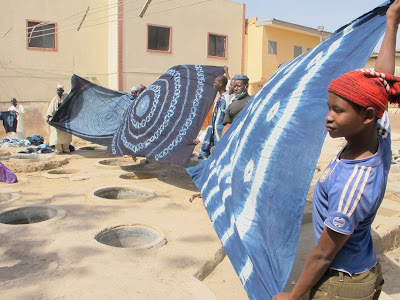Didn’t mean to go so long without posting a blog. Tom and I spent two weeks in Arizona over Christmas and had a very nice holiday. We enjoyed time with family and got to see our property for the first time. We flew back to Germany on New Year’s Eve.
I had a couple weeks in the office before traveling to Nigeria for a work trip. With a population of 152 million, Nigeria is the most populous country in Africa. It was a trip with our deputy to the commander for civil-military activities (DCMA). My
story about the trip is on the AFRICOM website.
The trip to Nigeria was supposed to be to Lagos (Nigeria's economic center), Abuja (the capital) and Kano but there were some mechanical problems with our plane, delaying our departure from Stuttgart a day and a half. The Lagos portion of the trip had to be canceled entirely but the activities in Abuja and Kano went forward.
We flew up to Kano, which is located in northern Nigeria, so that our DCMA could participate in a school commissioning ceremony. Some rehabilitation work and new construction was done at the school through a humanitarian activities project funded by Africa Command. Here are some pictures from around Kano.
 |
| Kano Mosque |
 |
| Streets of Kano - Nigeria's second most populous city |
 |
| A shop in Kano |
After the school ceremony, we had some extra time and we're able to go by one of Kano's famous dye pits. I found a
Reuters article online that talks about the Kano dye pits giving some good background. The dye pits are these circular ceramic pits that have been used for nearly 500 years. Dyers plunge fabric into water infused with indigo.
The journalist writes, "The purple cotton of Kano was once famous throughout Africa's arid Sahel belt, in the days when the Nigerian emirate was a center of trans-Saharan trade in salt and gold, rivaling the fabled riches of Timbuktu.
"The dying process has not changed in centuries: water and ash, to give the dye a glaze, is mixed with potassium, to fix the color. Finally, dried indigo twigs are added and the whole mixture is fermented in a six-meter deep pit for four weeks.
"The garments are then dipped in the dye for between 30 minutes and six hours, depending on the depth of color desired. Every minute, they must be taken out so that oxygen can aid the coloring process."
 |
| Manager tells us about the dye process |
 |
| Dye ingredients -- containers of ash, potassium and indigo |
 |
| A dyer lets the fabric breath |
 |
| Dyed fabric on display - I'm feeling a tie-dye vibe. |
 |
| Zango Dye Center |
This trip to Nigeria makes my fourth trip to Africa in the past year. I feel very blessed to have the opportunity to travel to Africa for work. Whenever I have the chance in Africa I like to go out to local restaurants and experience some local cuisine and culture. Usually staff at the U.S. Embassy can recommend good places to eat. In Abuja we had the opportunity to go to a bush bar for dinner. Here you eat with your hands and you get the WHOLE fish. It was delicious! Here are some pictures.
 |
| Fish on the grill |
 |
| Enjoying a great dinner with colleagues |
 |
| My dinner - YUM! |
 |
| I think I did a pretty good job cleaning my plate. |















Comments
Post a Comment